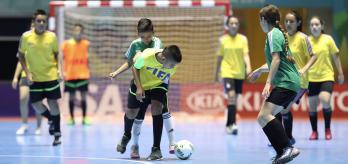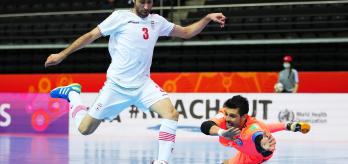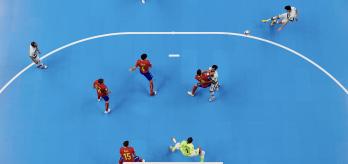High-block
In considering the positional status of a block, it is important to note that the block is generally a precursor to a press, although not always and as such the two actions should be considered mutually and separately. This is irrespective of the zone in which the opposition have possession.
The principle of the high-block is to keep the ball in the defensive zone 1 or, where it moves in to zone 2, to delay it in moving further forward. To be effective in a high-block, the out-of-possession team must mark man to man and, as a general rule, not pass players on. This requires a determination to track the marked player rather than pass them over. It is the precursor to the pressing action.
The line of three
A block will generally be performed by three out-of-possession players working in-line in a highly advanced position to slow the progress of the ball and keep it high up the pitch, generally by obstruction or the secondary application of a press.
Brazil, Argentina, RFU, Japan and Portugal were all effective exponents of this strategy. Another example came from Paraguay who demonstrated in the first half of their round of 16 game against Argentina, when they earned 1-0 lead at the break, what can happen if you put even the most capable teams under pressure. Argentina eventually won 6-1 but had had to work harder under the high-block to release the pressure.
Direct attacks, physicality and blocking
The application of a high-block was arguably a contributory factor to the high number of direct attacks seen across this tournament. Teams escaping the pressure could advance the ball swiftly once they had overcome the high-block.
On the transition from possession to out of possession, RFU and particularly Portugal caught the eye for their speed and athleticism in applying instant high-block positioning followed quickly by the press. Japan too, although they were less effective in transitioning quickly from the block to the press, and so allowed their opponents to move the ball on. On this point, the TSG highlighted the requirement for greater physicality from teams in order to apply immediate pressure.
We also identified the concept of blocking to delay and slow progress. Kazakhstan offered an example of this more passive approach, with Birzhan Orazov a central figure in their out-of-possession play. The mix of aggressive and more passive blocking of the opponent proved a beneficial tactic for Kazakhstan as they were able to profit from a loss of control or hesitation from their opponent.
High press
If anything, we saw an increased use of the high press by teams at this World Cup. As noted previously, the high-block was frequently the cue for a high press. Some teams were more effective than others at applying the appropriate pressure on the ball and then the opponent to block passing lines and direct the ball carrier off course.
Implementing the high press
If the key principles of defending are to ‘delay’, ‘deny’ and ‘deflect’, in terms of the press it is also imperative to consider the ‘trigger’ that sparks the high press. This is not the initial distribution from the opposition goalkeeper to a team-mate but the secondary pass and movement between outfield players.
Timing and understanding are vital components of an effective high press. When applied effectively, it can take as little as two passes by the opponent to effect a turnover or maybe longer depending on the skill-set of the team in possession.
The pressing, cutting of passing lines and denial of space by the out-of-possession team must be clinical and decisive with all players working in tandem and understanding their roles. Portugal and RFU offered exceptional examples of how to apply this tactic at this World Cup. It is here where futsal player intelligence and speed of thought is required to act in the blink of an eye to thwart the opponent.
A high press ideally requires all of the out-of-possession team to be in the opposition’s zones 1 and 2, denying space with a view to applying a block. Marking distances need to be sufficiently tight to challenge a pass, and to force the ball carrier into the easiest pass that can be shut down quickly. However, where the team in possession make a direct move to place a forward in the defenders’ zone 1 (pivot), this requires quick forward pressure on the ball to keep the press effective and negate the stretching of play.
The action of the press originates with the trigger as the first step towards the ball and ball carrier. Players must be equally fast and aggressive in shutting down space for any opponent who may receive the ball and this must continue as the ball is shifted on. The purpose is to deny the passing opportunity and, where the pass is made, to pressure the receiver and force an error or a pass that is misplaced – above all, to prevent the ball going forward.
Argentina provided some excellent examples of moving from a high-block to high press as did Portugal and this clearly frustrated their opponents. On many occasions it resulted in their regaining possession and the TSG identified this as an increasing norm in today’s game, certainly among the well-conditioned teams.
We should add that the application of the press does not always require three forward-positioned players as the reaction has to be driven by the in-possession set-up and therefore can be equally applied against an offensive 1-2-2 set-up although the principles remain the same.
Triggers and complete pressing
Effective pressure on all opponents is a key part of the press. Timing when to press and identifying the ‘trigger’ – an action that the entire squad can instantly identify – to initiate the pressure on first the ball then the opponent is vital in deploying this tactic. This requires a trained understanding of the various triggers to be adopted and is a core ‘coached’ component, as understanding the trigger is a skill in itself. Ball pressure applied at the wrong time, and without the full team’s involvement, can be costly and ineffective.
While teams may apply a block to delay their opponents, that effort can be wasted if they do not follow it up by putting pressure on the ball and cutting passing lines and options. On many occasions we witnessed a block that was passive and the pass still got played and this left the defence open. Therefore, after the first action to block, the defending team must then look to press. Some of the less experienced and less technical teams tried to press but failed to apply effective pressure on the non-ball carriers and therefore had limited success.
Pivots and physical capacity
Invariably we recognised the high-block initiated by the three foremost players in a 1-1-3 or a 1-2-1 defensive structure. Key to this approach was the marking of the highest-placed attacker, the pivot, to continually ensure the passing line from the ball to the pivot was obstructed or at risk. This had the impact of delaying the forward pass while the block moved closer to the ball carrier(s) to apply pressure on him to release the ball.
To offer one example, Ferrao (BRA) excelled in the group stage but was nullified later on in the competition once opponents had worked out how to limit his effectiveness in that role, and here Kazakhstan should be commended for their strategy to nullify his impact in the play-off for third place.
Of course, teams must have the physical capacity to press consistently. Portugal, always led by Ricardinho in the press, caused teams consistent problems in defensive zone 1 and were effective in regaining possession through forced errors or turnovers. For RFU, Ivan Chishkala and Robinho had a similar impact with their constant pressure and ability to work as a pair.
Automatic triggers, marking strategies and role of the keeper
In the view of the TSG, there is no single phase of play which is an automatic trigger for a high-block or press. That said, certain moments of play were cited: re-starts from the goalkeeper, offensive kick-ins from zone 1, and the build-up phase of open play starting in zone 1. The pressure applied in such instances may well account for the increased volume of direct attacks to evade the block or press.
At this World Cup we saw a mixed approach to marking strategies. For a block or press to be effective requires man-to-man marking and, importantly, the tracking of the marked player as they seek to relieve the pressure applied on them or the passing lines they seek to open up. Tracking versus passing over is, for some teams an untrained principle but is a necessary facet of a high-block or press.
Consequently when some teams sought to apply a mixed marking strategy – in some cases passing players on to team-mates as they struggled to effectively enact the press – they were generally less successful. For pressure to be effective it has to be continual, especially in futsal as the spaces in which to deliver a pass are small.
Thus the passing or transfer of an opponent can create a weakness in the block or press which the opponent can exploit. Of course, the initial action of the block is to deny space and block passing lines, whereas the transition to the press demands a full-on, touch-tight approach with the opponent always within touching distance in order to reduce space, angles and opportunity.
The role of the goalkeeper in the high-block or press is also an interesting development. The goalkeeper has a role to play in supporting the high press particularly now they are acting in more advanced positions as the final and additional defender – as this tournament evidenced.
Conclusion
Overall, we saw a mixed use of the high press throughout this World Cup. Some sides, such as Portugal, RFU and Argentina, used the press as part of an overall game strategy to harass and destabilise their opponent from the outset. Others, such as Vietnam, used it in isolated instances and infrequently; in their case only once in their four games, against Panama. There were others who adopted a high press when they faced an adverse scoreline and wanted to exercise pressure, albeit it was often too late in the game to have an impact.
The TSG were of the opinion that effective high pressing is becoming a game-changing feature of play in futsal. The high-block/press has been increasingly adopted over the last five years where previously teams adopted a passive mid-block approach almost universally. Yet this has changed and those teams at the forefront of the high-block/press have benefitted. It has had a knock-on effect on the approach of the in-possession team too (reverting to direct attack). There is no doubt that effective high pressing requires a trained mindset, skill set and highly athletic players, and a collective understanding is crucial for it to be deployed successfully.
This is a positive development for game play at international level and over the next decade we expect to see significant further developments in this area although we would advise caution over the use of this strategy without the appropriate technical ability of players or understanding from the coaching staff of how, why and when to use it. It was evident at this World Cup that some higher-ranked teams did not respond well to high pressure and this may impact on the hierarchy of international futsal with those who can cope and adapt to this tendency coming to the fore.



































